Rumney Marsh Burial Ground is nestled in the middle of a quiet neighborhood in Revere, Massachusetts. Its first recorded burial was in 1693, and over the years it became the final resting place for generations of the area’s earliest families, with links to what is now Chelsea, Winthrop, and East Boston as well as Revere. Veterans of the Colonial Wars, Revolutionary War, War of 1812, and the Civil War lie here, as do a number of slaves who are buried along the boundary of the cemetery. Notable historical figures buried here include Deane Winthrop (a son of Governor John Winthrop), and Revolutionary War heroes such as Captain Samuel Sprague and “The Fighting Pastor” Phillips Payson. The final burial took place in 1929, but Rumney Marsh Burial Ground (hereafter referred to as RMBG) remained a part of Revere’s community. The cemetery is cared for by a dedicated committee, and as such is a remarkably well-kept piece of New England history.
The first white man to claim ownership of the land on which RMBG sits was Samuel Cole. Cole opened Boston’s first “house of entertainment” in 1633 and was reprimanded several times for charging too much for his beer. Cole owned houses in Boston and Rumney Marsh, the latter of which stood at the corner of Winthrop and Hillside Avenues until 1933. In 1653 Cole sold a portion of his land to William Hasey, patriarch of a family whose name appears frequently in RMBG. Upon William’s death in 1689 the land was divided in half between his sons William and Joseph. In 1690 an outbreak of smallpox led to people fleeing Boston for places like Rumney Marsh. To curb the spread of the disease it was ordered that the bodies of anyone who died of smallpox could not be returned to Boston, and anyone who tried to sneak a corpse back into Boston would be subject to a fine of five pounds. This situation led the Hasey brothers to set aside some of their land for a new burial ground.
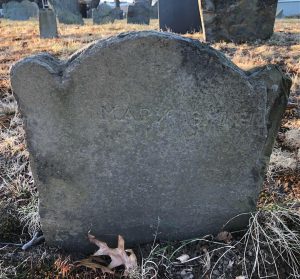
The first recorded burial was Mary Smith in 1693. Her headstone does not remain but her footstone does; it bears no adornment but the name carved somewhat crudely in capital letters. The absence of Mary Smith’s headstone makes the oldest intact headstone in RMBG that of the second William Hasey, buried in 16951His father WIlliam is buried in the old cemetery on the shores of Wakefield’s Lake Quannapowitt. There were regular burials throughout the early 1700s, but the land did not officially become a burial ground until the 1740s. At this point the land belonged to Joshua Cheever, who gave the RMBG section to the city in 1743. His will, dated October 20, 1750, made it official: “The burying ground in my land at Chelsea I give the same to the said town forever.” Hundreds of people were interred in RMBG until the number of burials tapered off in the latter half of the 1800s, likely due to space considerations and the emergence of larger nearby cemeteries such as Woodlawn Cemetery in Everett, Holy Cross Cemetery in Malden, and Winthrop Cemetery2Belcher, Floyd, and Tewksbury are some of the names that one will see frequently in both RMBG and Winthrop Cemetery.. The final burial in RMBG, that of Civil War veteran Lewis Bullard, took place in 1929.
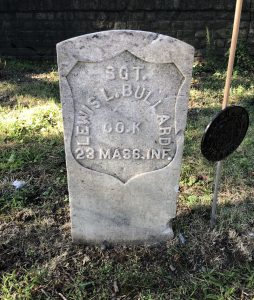
After it ceased to be an active cemetery, upkeep of RMBG became sporadic, as was the case with many old New England cemeteries. Nonetheless, RMBG continued to play a role in the life of Revere. Many residents of a certain age recall playing hide and seek among the tombstones, collecting chestnuts from the trees, and even riding bikes in the cemetery. Revere’s Memorial Day activities once included a Little League parade that paused at RMBG where a ceremony was held. Many Reverians have fond memories of these ceremonies.
The Rumney Marsh Burial Ground Renovation Committee was formed in the early 2000s by concerned members of the community and has flourished since. The annual Bocce On the Beach tournament has become one of Revere’s most beloved summer traditions, and it raises money for the upkeep of the burial ground. Thanks to the efforts of this committee, RMBG is in much better shape than many cemeteries of similar vintage.
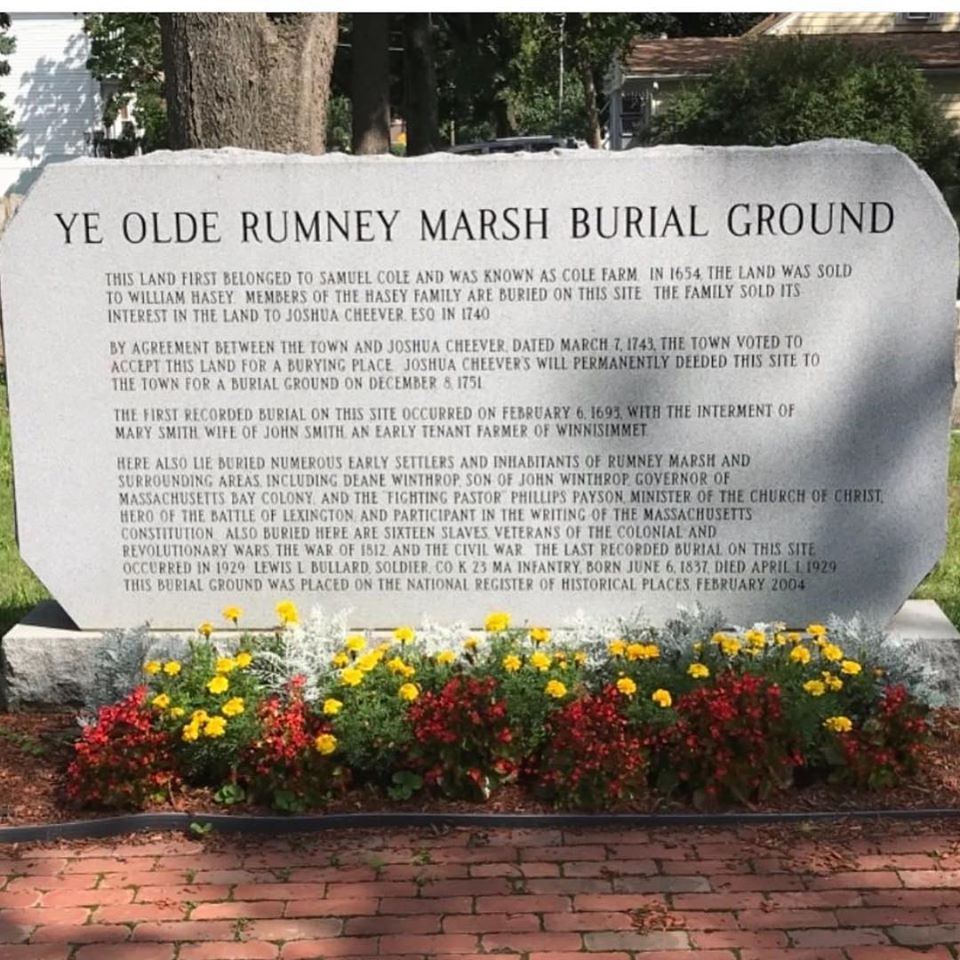
If you were to visit the burial ground you would first notice two large stones: one bearing a plaque commemorating the names of RMBG’s soldiers, and another giving the short version of RMBG’s history. A stone honoring Charles James Bibber, Revere’s Congressional Medal of Honor recipient, lies to the right of the soldier plaque. Behind the history stone are two more plaques which commemorate the burials of enslaved persons along the Butler Street wall of RMBG. All of these burials are unmarked, but local historians were able to verify their locations with the help of an 1897 map of the burial ground. An interesting name found here is Job Worrow, who appears on both the slave and soldier plaques. According to that 1897 map, Worrow and his wife Betty are actually buried in the northeast corner of RMBG along with another slave named Fanny Fairweather, who it is believed once had a gravestone that went missing.
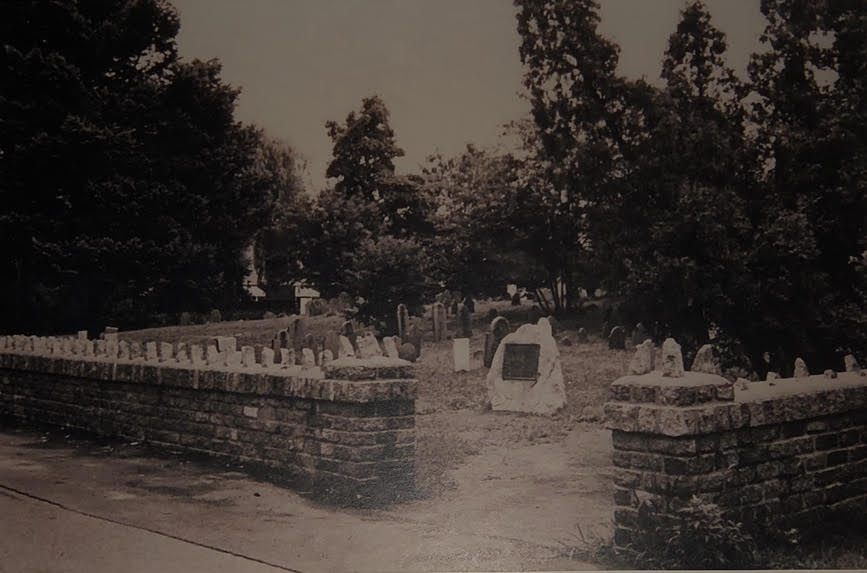
Most of the oldest graves in the cemetery are clustered around a large tree in the rear of the cemetery. If you make your way in that direction from the slave plaques, you will notice certain names pop up repeatedly3Some names are spelled several different ways – Eustis also appears as Uestis, Hasey as Hascy and Harscy: Eustis, Oliver, Floyd, Bill, Hasey, Cheever; names of Revere’s oldest families, which also appear on street signs throughout the city. In a row of Cheevers you will find the stone for Reverend Thomas Cheever, the first settled minister of Rumney Marsh’s first church. This area also includes the aforementioned Mary Smith, William and Joseph Hasey, and many interesting examples of early New England gravestone art. The earliest popular design for New England gravestones was a toothy skull with wings, meant to remind observers of the inevitability of their own death and the hope of resurrection. The skulls are often accompanied by Latin messages like “Memento Mori” (remember death) and “Fugit Hora” (time flies) just to hammer the point home.
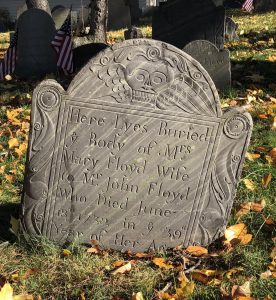
Moving back towards the center of the cemetery you will find more stones of historic interest and aesthetic merit. Most prominent is the large block marking the burial of Reverend Phillips Payson and his wife Elizabeth. Payson is known as “The Fighting Pastor” due to his brief engagement in the Revolutionary War. Payson is surrounded by family members, whose gravestones bear the willow and urn and winged cherub motifs which began to replace the winged skull as attitudes towards death softened.

The Cary family slab next to the Payson plot marks the remains of another of Revere’s important early families. Their house, the Bellingham-Cary House, still stands in nearby Chelsea. The first two names on the slab, Samuel and Sarah, made their fortune from a successful sugar plantation in Grenada. The Carys were not originally buried in RMBG, but in a tomb beneath the first church in Revere. There are markers scattered throughout RMBG that indicate other families whose remains were relocated from these tombs to the burial ground in 1910.
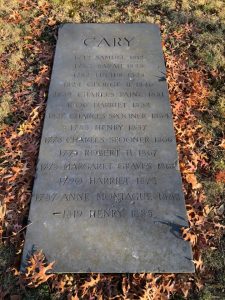
Also of interest in this general area is the stone for Deane Winthrop, which is annually decorated with flowers by the Winthrop Improvement and Historical Association. RMBG’s link to the Salem Witch Trials, the gravestone of Sarah Doolittle Floyd, can be found a few yards away and identified by its odd shape which suggests the angles of a coffin. It was not Sarah Floyd who was accused but rather her husband John. Another stone of note is that belonging to Sarah Williams. While I have never been able to find any biographical information about her, the carving on the tympanum4The tympanum is the top part of the stone which features the main decorative image. of her tombstone is the most unique design in RMBG.
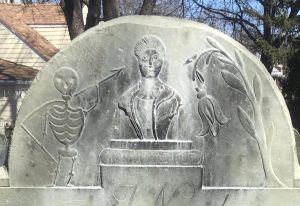
As one proceeds to the far end of the cemetery, one will see the Civil War plot and the cannonball memorial. Thirteen stones commemorate some of Revere’s Union soldiers, though at least one of these men is actually buried in Everett’s Woodlawn Cemetery. According to an RMBG committee member, damage to the cannonball memorial resulted in a creative bit of do-it-yourself repair: basketballs painted black and treated to be indistinguishable from the cannonballs.
Following the path back towards the entrance you will see other frequent names: Tewksbury5Which also appears throughout as Tuksbury and Teuksbury., Sale, Low, Green, and Pratt. Many of these marble stones are faded and eroded, and there are a few sets of fragments embedded in concrete. About halfway along the path is the grave of Captain Samuel Sprague, the leader of the local militia during the Revolutionary War. As you return to the gate the last notable memorial you will see is not a grave but a bench dedicated to Peter MacCauley, Revere’s great historian, who once lived next door to RMBG.
Notable Burials of RMBG
Bibber, Charles James
While Bibber is not actually buried in RMBG, the prominence of his memorial stone merits his inclusion on this list. Bibber was awarded the Congressional Medal of Honor for his service in the Civil War aboard the USS Agawam. Bibber died in Revere in 1883 and is buried in Everett’s Woodlawn Cemetery.
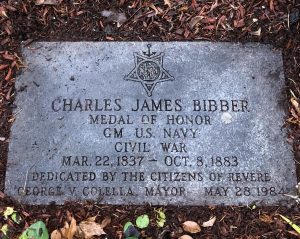
Cary, Samuel and Sarah
The Carys were a successful merchant family who owned a plantation in the West Indies. The Cary family came to own Governor Bellingham’s mansion in 1765 and used their wealth to plant trees and improve the interior of the house, which still stands. The book Sarah Gray Cary from Boston to Grenada describes how she played a role in the family business while raising 13 children.
Cheever, Thomas
Thomas Cheever became the first settled minister in Revere in 1715. He had preached in Malden in the 1680s but his career was derailed by scandal; he was accused of adultery, breaking the Third Commandment, and using “obscene expressions in a Salem tavern.” He redeemed himself in Revere, where he preached for 30+ years and opened Revere’s first public school in his home.
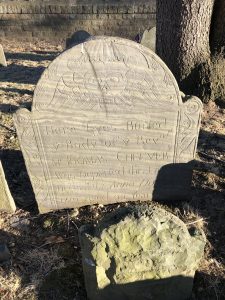
Floyd, Sarah
Sarah Floyd’s husband John was accused of witchcraft during the Salem Witch Trials of 1692. His military service in Saco, Maine lodged him in the minds of the Salem Village accusers, some of whom had lived in Saco and lost parents to the conflicts between settlers and Native Americans. He is buried in Lynn’s Western Burial Ground.
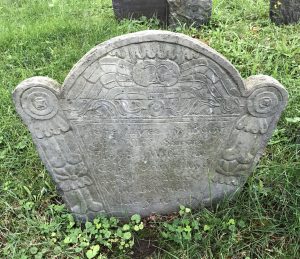
Payson, Phillips
The “Fighting Pastor” is an interesting figure in Revere’s history. According to historical sources he took his time deciding who to back as the Revolution was heating up. He made up his mind decisively, however, when he rounded up a group of men and attacked a small British troop, killing one and stealing all of their supplies. In addition to his brief military service, Payson formed a school for young men who wished to be ministers, and aided in the establishment of the American Academy of Arts and Sciences.
Sprague, Samuel
At 63 years of age Samuel Sprague took charge of the local militia during the Revolutionary War. He and his men took part in the removal of livestock from Hogg Island (now Orient Heights) which precipitated the Battle of Chelsea Creek, the first naval engagement of the Revolution. While the record is not 100% clear, he may have taken part in and been wounded at the Battle of Bunker Hill.
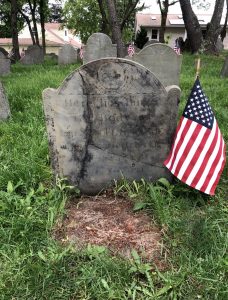
Winthrop, Deane
Deane Winthrop’s father John Winthrop was governor of the Massachusetts Bay Colony for 12 of its first 20 years. Deane’s house, which still stands in Winthrop, is the oldest continuously inhabited home in the United States. He lived in Winthrop his entire adult life, but was involved in settling the Plantation of Groton in 1655. The famous Salem Witch Trial judge Samuel Sewall was present at Winthrop’s funeral.
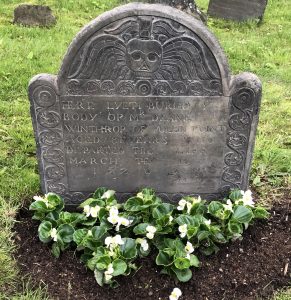
Worrow, Job
Job Worrow is unique in the history of Revere in that he was an enslaved person and a Revolutionary soldier. He was among a group of 17 men stationed as a guard in Pullen Point, now Winthrop. Some sources wonder what 17 men were supposed to do against a British troop, but these men held their post for 30 days and certainly did not lack in valor. Worrow seems to have gone on to become a well-known local character, for the book “A Documentary History of Chelsea” contains the following passage: “Later he lived at Point Shirley, where he and his wife occupied a house with but one room. Many stories are still repeated of the tricks played upon old black Job by the youngsters of the old days. A few people now living remember seeing him when he was a very old man. He is said to have died in the poorhouse in Chelsea, now Revere, at the age of 100 years.”
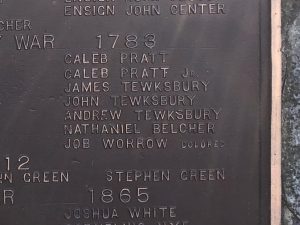
Some additional facts about RMBG and Revere, MA:
- It is the resting place of at least 545 of Revere’s earliest settlers
- The 3 x 2 wall was built as a WPA project from the 1930s.
- The inscriptions are facing west and bodies east towards the rising sun.
- In 1739, Rumney Marsh was considered a part of Chelsea and became a part of North Chelsea in 1846. In 1871, the name was officially changed to Revere.
Information from: The Rumney Marsh Burying Ground DVD, courtesy of Sound and Vision Media, Revere, MA. and The History of Revere (1938) by Benjamin Shurtleff.
